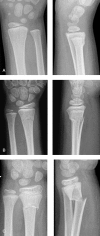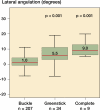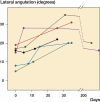Distal radius fractures in children: substantial difference in stability between buckle and greenstick fractures
- PMID: 19916694
- PMCID: PMC2823323
- DOI: 10.3109/17453670903316850
Distal radius fractures in children: substantial difference in stability between buckle and greenstick fractures
Abstract
Background and purpose: Numerous follow-up visits for wrist fractures in children are performed without therapeutic consequences. We investigated the degree to which the follow-up visits reveal complications and lead to change in management. The stability of greenstick and buckle fractures of the distal radius was assessed by comparing the lateral angulation radiographically.
Patients and methods: The medical records of 305 distal radius fractures in patients aged less than 16 years treated at our institution in 2006 were reviewed, and any complications were noted. The fracture type was determined from the initial radiographs and the angulation on the lateral films was noted.
Results: Only 1 of 311 follow-ups led to an active intervention. The greenstick fractures had more complications than the buckle fractures. The lateral angulation of the buckle fractures did not change importantly throughout the treatment. The greenstick fractures displaced 5 degrees on average, and continued to displace after the first 2 weeks. On average, the complete fractures displaced 9 degrees .
Conclusion: Buckle fractures are stable and do not require follow-up. Greenstick fractures are unstable and continue to displace after 2 weeks. Complete fractures of the distal radius are uncommon in children, and highly unstable. A precise classification of fracture type at the time of diagnosis would identify a smaller subset of patients that require follow-up.
Figures




References
-
- Al-Ansari K, Howard A, Seeto B, Yoo S, Zaki S, Boutis K. Minimally angulated pediatric wrist fractures: is immobilization without manipulation enough? CJEM. 2007;9((1)):9–15. - PubMed
-
- Alemdaroglu KB, Iltar S, Cimen O, Uysal M, Alagoz E, Atlihan D. Risk factors in redisplacement of distal radial fractures in children. J Bone Joint Surg (Am) 2008;90((6)):1224–30. - PubMed
-
- Brudvik C, Hove LM. Childhood fractures in Bergen, Norway: identifying high-risk groups and activities. J Pediatr Orthop. 2003;23((5)):629–34. - PubMed
-
- Cannata G, De MF, Mancini F, Ippolito E. Physeal fractures of the distal radius and ulna: long-term prognosis. J Orthop Trauma. 2003;17((3)):172–9. - PubMed
-
- Davidson JS, Brown DJ, Barnes SN, Bruce CE. Simple treatment for torus fractures of the distal radius. J Bone Joint Surg (Br) 2001;83((8)):1173–5. - PubMed
Publication types
MeSH terms
LinkOut - more resources
Full Text Sources
Medical
